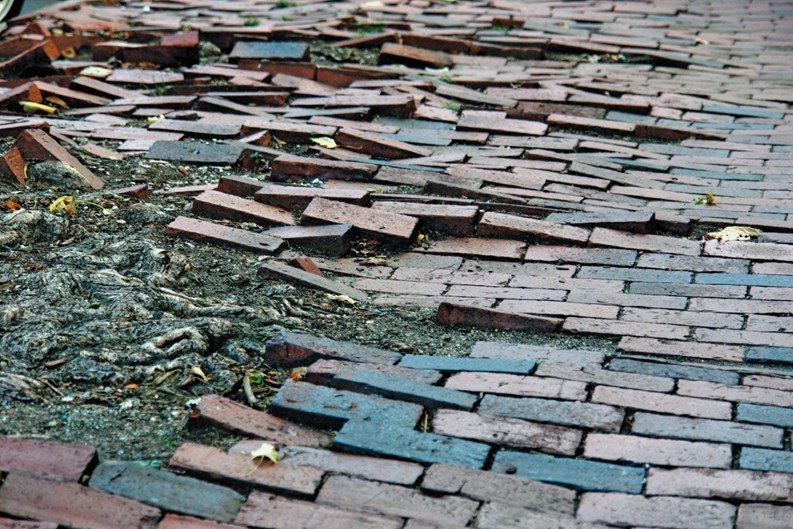When it comes to residents’ safety within a condominium community, it’s the tragedies such as pool drownings, fires and floods that make headlines. But the real villains – measured by the number of actual accidents – are the subtle flaws around the condo that literally “trip people up” and result in all sorts of injuries.
So what are the real dangers, and what more can property managers and trustees do to improve safety in their communities?
Topping the list, says Walt Williamsen, owner of Condominium Consulting Services of Torrington, Connecticut, “are tripping hazards.” Walkways, stairs and their surface conditions – wherever people tread –probably cause more tripping and falling incidents than anything else, he notes. “Defective sidewalks are a major issue… when they have heaved or separated, caused by tree roots or water infiltration with freezing and thawing. Potholes can form in pavement where people walk. Then there’s ice when water pools from lack of efficient drainage.”
Williamsen’s company inspects client properties on a regular schedule, specifically looking for hazards – or potential hazards. While building codes in most states incorporate safety into their specifications, many older residential projects pre-date codes and it’s up to association directors or managers to retro-fit. As an example, states Williamsen, “Older buildings may not have rails on stoops or entry stairways. Even when railings are in place, are the balusters no more than four inches apart?” Building codes are strict, he adds, “and require that stair treads be evenly spaced –both the height and width of each step. Over time, I have seen even concrete steps decay, crack and shift.” When it comes to stairs, minor variations and flaws that are barely noticeable can trip people up, he adds.
Decks “Coming of Age”
Just as stairs and rails need scrutiny, many decks installed 30-plus years ago at townhouse communities are now “coming of age.” Williamsen reports that “decks are a major issue now because structurally, they can be decayed… At a community recently we had to put yellow [police] tape around a deck outside one unit because it was so dangerous.” The specifications for deck construction have evolved considerably since the earliest designs that used untreated [rot-prone] lumber, which was often simply nailed to the sides of homes. Most of these older decks have been replaced with much sturdier, safer materials –and if they haven’t, they should be, he adds.
One other area that has changed considerably, for safety reasons, is the pool –a favored amenity at many communities despite ever-tightening regulations. Williamsen notes that pools are subject to local and state health codes, “but a most recent law came from the federal government,” in response to a tragic drowning. In that incident, a young girl drowned when she was trapped by the current from a hot tub drain. All pools and spas are now federally mandated to have drain covers, breakaway drains and suction shut-offs to prevent such tragedies.
Sometimes safety practices are dictated by insurance companies. That’s why community pools no longer have diving boards, whether accidents ever occurred or not. Williamsen points out that the most recently-built communities that he services do not include pools, “although most new, local, condo projects in recent years have been over-55 age restricted, and that may be a factor.”
One aspect in pool maintenance that may be of concern, he states, “is mold… I just [did a report] on a pool house that was loaded with mold.” And mold, as with other aspects of pool management such as chemical balance in the water and general cleanliness, is an example of a safety issue that’s also under the jurisdiction of health codes.
Annual Checkups
Accidents within communities, especially fires, are almost always a result of human error, says Pat Ruggiero, property manager with G&W Management in Hartford, Connecticut. In one example, she reports, “We had a major fire… in a multi-unit building. It started at a child’s birthday party. A parent stuck sparklers on a cake, lit them up and left it on a bed, then went out of the room to get the child…”
She recommends that managers “go through properties on a yearly basis to check fire extinguishers, emergency lighting, walks and stairs. We typically do a walk-through in the spring and then set a list of projects that can be done during the summer construction season. Safety is a major focus of theseinspections, and we also look out for potential problems with drainage… at catch basins and culverts, anywhere where poor drainage could result in water pooling and icing up in the winter.”
Also each year, she adds, “Residents should be reminded to check smoke alarms. Also, make sure lighting fixturesare sufficient to properly illuminate all common areas… and outdoors.”
Her firm also services some high-rise buildings, where safety issues take on a slightly different perspective. “With a high-rise, we utilize some sophisticated fire alarms serviced with a maintenance contract. The local fire department comes in regularly and talks to the residents about escape routes and elevators and other special precautions.”
And for communities with pools, Ruggiero has found that “in order to get insurance at these properties, thereare no diving boards. Also, a lot of the pool areas now have a key entry system, to discourage non-residents from getting in. Most pools don’t have staff to monitor pool areas, and rely on rules that are posted. This means that infractions will result in complaints from pool users, like when there’s unsupervised children acting up or horseplay. Then it’s up to management to follow through” so that there’s no recurrence.
Rules that are intended to prevent accidents and keep residents safe are useless if they’re not enforced, she insists. Residents may need regular reminders about infractions such as blocking exit doors or hallways, parking in fire lanes and using charcoal grills on wooden decks. “If you don’t enforce the rules, your insurance company will,” in the form of higher premiums or loss of coverage, she warns. “Insurance companies conduct a loss-prevention inspection before they approve you for another year.”
She notes that associations can use fines as an enforcement tool. “If you can hit their pocketbook, residents will pay attention.”
While enforcement may be difficult or unpleasant – both for managers and for rule-breakers – it’s still far better than a tragedy that can be prevented with attention to a simple rule or regulation. While disasters and major accidents are indeed rare, there’s no reason to accept them as inevitable within a community. Unit owners, trustees and management are in a unique position to support health and safety, since they can employ a level of control over their immediate environment. It may be oneof the reasons people choose community living in the first place.
Marie Auger is a freelance writer and a frequent contributor to New England Condominium magazine.







Leave a Comment